Fluticasone Propionate 50 Micrograms Aqueous Nasal Spray

Read all of this leaflet carefully before you start using this medicine because it contains important information for you.
Keep this leaflet. You may need to read it again.
If you have any further questions, ask your doctor or pharmacist.
This medicine has been prescribed for you only. Do not pass it on to others. It may harm them, even if their signs of illness are the same as yours.
If you get any side effects, talk to your doctor or pharmacist.
This includes any possible side effects not listed in this leaflet. See Section 4.
Your medicine is available using the above name but it will be referred to as 'Nasofan Nasal Spray' throughout this package leaflet.
What is in this leaflet:
1. What Nasofan Nasal Spray is and what it is used for
2. What you need to know before you use Nasofan Nasal Spray
3. How to use Nasofan Nasal Spray
4. Possible side effects
5. How to store Nasofan Nasal Spray
6. Contents of the pack and other information
1. WHAT NASOFAN NASAL SPRAY IS AND WHAT IT IS USED FOR
Your medicine contains 50 micrograms of the active ingredient, fluticasone propionate, in each spray. Fluticasone propionate is one of a group of medicines known as corticosteroids.
Nasofan Nasal Spray has anti-inflammatory properties. When sprayed into your nose it will reduce swelling and irritation. It is used to prevent and treat seasonal allergic rhinitis (e.g. hayfever) and perennial rhinitis (e.g. blocked or runny nose and sneezing and itching caused by house dust mites or animals such as cats and dogs). It can be used by adults and children aged 4 years and older.
2. BEFORE YOU USE YOUR NASOFAN NASAL SPRAY
Do not use Nasofan Nasal Spray:
• if you are allergic to fluticasone propionate or any of the other ingredients of this medicine (listed in section 6).
Warnings and precautions
Talk to your doctor or pharmacist before using
Nasofan Nasal Spray:
• if you have ever had an operation to your nose
• if you are suffering or have recently suffered from an infection of the nasal airways
• if you are suffering or have recently suffered from any type of untreated infection or from tuberculosis or ocular herpes
• if you have recently been treated with injected steroids, or you have been taking oral steroids for a long time.
Nasofan Nasal Spray will usually control seasonally
allergy rhinitis (hay fever) however if you are
exposed to excessive amounts of pollen additional
therapy may be helpful for controlling other symptoms such as itching eyes. Please consult your doctor in such an event.
Other medicines and Nasofan Nasal Spray
Tell your doctor or pharmacist if you are using, have recently used or might use any other medicines.
Some medicines can interfere with Nasofan Nasal Spray, in particular tell your doctor or pharmacist if you are taking:
• Any medicines used in the treatment of fungal infections (e.g. ketoconazole)
• Any antiviral medicine such as those used to treat HIV infection (e.g. ritonavir)
Pregnancy and breast-feeding
If you are pregnant or breast-feeding, think you may be pregnant or are planning to have a baby, ask your doctor or pharmacist for advice before taking this medicine.
Driving and using machines
The medicinal product has no or negligible influence on the ability to drive and use machines.
Nasofan Nasal Spray contains benzalkonium chloride solution
Nasofan Nasal Spray contains the ingredient benzalkonium chloride solution (40 micrograms per delivered dose) which is an irritant and may cause skin reactions. If used for longer periods, the preservative benzalkonium chloride may cause nasal mucosa swelling. In case of such a reaction (persistently congested nose) medicinal products for nasal use without preservative should be used if possible. It may also cause bronchospasm. Unless such products are available another pharmaceutical form should be taken. It may also cause bronchospasm.
Once your symptoms are under control your doctor may reduce your dose to one spray into each nostril once a day. If the use of such a reduced dose signals a worsening in your symptoms, your dose may be increased back to the starting dose.
Children aged 4 to 11 years:
For children aged between 4-11 years old the dose is normally one spray in each nostril once a day, preferably in the morning. Your doctor may increase this to a maximum of one spray into each nostril twice a day.
This product is not suitable for children under 4 years old.
Your doctor will prescribe the lowest dose of Nasofan Nasal Spray capable of effectively controlling your symptoms.
It may take a few days for this medicine to work. Do not stop using your medicine unless you are told to by a doctor.
You must not take a larger dose, or use your Nasofan Nasal Spray more often, than is prescribed by your doctor. It is important not to use more of your medicine than your doctor has told you to.
If your eyes remain itchy or watery as a result of hayfever despite using this medicine tell your doctor. He/she may be able to give you another medicine to treat your eye symptoms.
Before you use your nasal spray
Your Nasofan Nasal Spray has a dust cap that protects the nozzle and keeps it clean - this must be taken off prior to using the spray and then replaced after use.
If you have not used your Nasofan Nasal Spray for 7 days prime until a fine mist is produced.
If after attempting to prime the bottle the spray still does not work and you think it may be blocked you may clean the spray using the following procedure:-
Cleaning your nasal spray
1. Remove the dust cap.
2. Pull the white collar upwards to remove the nozzle.
3. Place the nozzle and dust cap in warm water and soak for a few minutes, and then rinse by placing under a running tap.
4.
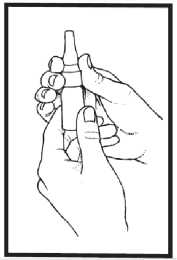
Shake off the excess water and allow the nozzle and dust cap to dry in a warm (not hot) place.
5. Re-fit the nozzle.
6. 'Prime' the bottle as necessary by pumping the spray a few times until a fine mist is produced.
• You should clean your nasal spray at least once a week to stop it from getting blocked up. Additional cleaning is required when your spray becomes blocked.
• You must NEVER attempt to unblock or enlarge the spray hole with a pin or other sharp object because this will destroy the spray mechanism.
3. HOW TO USE NASOFAN NASAL SPRAY
Always use this medicine exactly as your doctor or pharmacist has told you. Check with your doctor or pharmacist if you are not sure.
The recommended dose is as follows:
Adults (including the elderly) and children aged 12 years and older:
When you first start using Nasofan Nasal Spray you normally take two sprays in each nostril once a day, preferably in the morning. Your doctor may increase this to a maximum of two sprays into each nostril twice a day.
When your Nasofan Nasal Spray is new the bottle must be primed as follows:-1. Shake the bottle gently and then remove the dust cap.
2. Hold the bottle upright with your thumb under the bottle and your index finger and middle finger on either side of the nozzle. Ensure that the nozzle is pointing away from you when you do this.

3. Press down with fingers in order to pump the spray.
4. Repeat steps 2 and 3 until a further five times -the bottle is now primed.
3. Close one nostril by pressing your finger against it and place the nozzle of the spray in your other nostril. Tilt your head forward slightly so that the bottle is kept upright.
4. Breathe in slowly through your open nostril and, at the same time, press the collar of the nozzle down firmly with your fingers to squirt a spray of fine mist into your nostril.
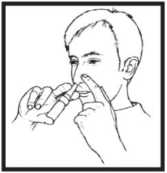
5.
6.
7.
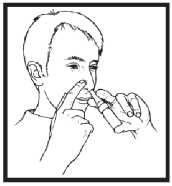
Breathe out through your mouth. Repeat step 4 to take a second spray into the same nostril.
Remove the nozzle from this nostril and breathe out through your mouth.
Repeat steps 3 to 6 with your other nostril.
After using your nasal spray
• Wipe the nozzle carefully with a clean tissue and put the dust cap back on.
If you use more Nasofan Nasal Spray than you should
It is important that you take your dose as stated on the pharmacist's label or as advised by your doctor. You should use only as much as your doctor recommends; using more or less may make your symptoms worse.
If you accidentally use more Nasofan Nasal Spray than you were told to use please inform your doctor.
Take this leaflet, and your Nasofan Nasal Spray, to show the doctor.
If you forget to use Nasofan Nasal Spray
Do not take a double dose to make up for a forgotten dose. If you forget to take a dose at the right time, take it as soon as you remember. If it is almost time to take the next dose, wait until then and then carry on as before.
If you stop using Nasofan Nasal Spray
Your nose symptoms may only start to improve after you have been using your medicine for a few days -therefore it is very important that you use your medicine regularly as prescribed, and that you keep using your medicine unless your doctor tells you to stop, even if you feel better.
If you have any further questions on the use of this medicine, ask your doctor or pharmacist.
4. POSSIBLE SIDE EFFECTS
Like all medicines, this medicine can cause side effects, although not everybody gets them.
If you are using high doses of Nasofan Nasal Spray you may require extra steroids in times of extreme stress, or during admission to hospital after a serious accident or injury, or before a surgical operation. Treatment with nasal corticosteroids may affect the production of steroids in the body. The likelihood of such an incidence is increased by use of a high dose over a long period of time. Your doctor will help prevent this happening by prescribing the lowest dose of steroid capable of adequately controlling your symptoms.
Some side effects are more serious than others and if you should experience any of the following events you should discontinue taking Nasofan Nasal Spray and consult with your doctor as soon as possible:-
Side effects occurring very commonly (probably affecting more than 1 in 10 patients taking the Nasofan Nasal Spray)
• epistaxis (nose bleeds).
Side effects occurring commonly (probably affecting up to 1 in 10 patients taking the Nasofan Nasal Spray)
• headache
• unpleasant taste in the mouth or an unpleasant smell in the nose
• dryness and irritation of the throat and nasal passages and sneezing.
Side effects occurring rarely (probably affecting fewer than 1 in every 1,000 patients taking Nasofan Nasal Spray)
• severe allergic reaction giving rise to the sudden onset of a rash, swelling (usually of the tongue, face or lips) or difficulty in breathing
• bronchospasm (the narrowing of the airways in the lungs).
Side effects occurring very rarely (probably affecting fewer than 1 in every 10,000 patients taking the Nasofan Nasal Spray)
• glaucoma (raised pressure in the eye) and cataracts (clouding of the lens in the eye) have been reported following prolonged treatment
• perforation of the nasal septum (the dividing partition in the nose) and ulceration to the nose's mucus membranes - although these usually impact on patients who have had previous surgery to the nose.
Additional side effects in children and adolescents
Children may grow more slowly than others, and therefore children receiving treatment with nasal corticosteroids over a long period of time will have their height checked regularly by their doctor. Your doctor will help prevent this happening by prescribing the lowest dose of steroid capable of adequately controlling the symptoms.
Reporting of side effects
If you get any side effects, talk to your doctor, pharmacist or nurse. This includes any possible side effects not listed in this leaflet. You can also report side effects directly via the Yellow Card Scheme at: www.mhra.gov.uk/yellowcard.
By reporting side effects you can help provide more information on the safety of this medicine.
5. HOW TO STORE NASOFAN NASAL SPRAY
• Keep out of the sight and reach of children.
• Do not store above 25°C.
• Do not use Nasofan Aqueous after the expiry date that is stated on the outer packaging. The expiry date refers to the last day of that month.
• Medicines should not be disposed of via wastewater or household waste. Ask your pharmacist how to dispose of medicines no longer required. These measures will help to protect the environment.
6 . FURTHER INFORMATION
What Nasofan Aqueous Nasal Spray contains:
• Each metered spray gives 50 micrograms fluticasone propionate per spray in an aqueous suspension.
• Also contains: glucose anhydrous, microcrystalline cellulose, carmellose sodium, phenylethyl alcohol, benzalkonium chloride, polysorbate 80, purified water.
What Nasofan Aqueous Nasal Spray looks like and contents of the pack:
• White opaque suspension in an amber glass bottle fitted with an atomising metered pump to create the spray.
• Each bottle contains sufficient suspension to deliver 150 metered sprays.
Manufacturer by:
Teva Czech Industries s.r.o,
Ostravska 29,
747 70 Opava- Komarov,
Czech Republic.
Procured from within the EU & repackaged by Product Licence holder:
Kosei Pharma UK Ltd.,
956 Buckingham Avenue,
Slough Trading Estate,
SL1 4NL, UK
Nasofan® Aqueous 50 microgram Nasal Spray, Suspension PL 39352/0299
Nasofan® is a registered trademark of Teva. Leaflet date: 29.02.2016

Nasofan® Aqueous 50 microgram Nasal spray, Suspension
(fluticasone propionate)
Fluticasone propionate 50 micrograms Aqueous Nasal Spray,
Suspension
(fluticasone propionate)
Package Leaflet: Information for the user
Read all of this leaflet carefully before you start using this medicine because it contains important information for you.
Keep this leaflet. You may need to read it again.
If you have any further questions, ask your doctor or pharmacist.
This medicine has been prescribed for you only. Do not pass it on to others. It may harm them, even if their signs of illness are the same as yours.
If you get any side effects, talk to your doctor or pharmacist.
This includes any possible side effects not listed in this leaflet. See Section 4.
Your medicine is available using the above name but it will be referred to as 'Fluticasone propionate Nasal Spray' throughout this package leaflet.
What is in this leaflet:
1. What Fluticasone propionate Nasal Spray is and what it is used for
2. What you need to know before you use Fluticasone propionate Nasal Spray
3. How to use Fluticasone propionate Nasal Spray
4. Possible side effects
5. How to store Fluticasone propionate Nasal Spray
6. Contents of the pack and other information
1. WHAT FLUTICASONE PROPIONATE NASAL SPRAY IS AND WHAT IT IS USED FOR
Your medicine contains 50 micrograms of the active ingredient, fluticasone propionate, in each spray. Fluticasone propionate is one of a group of medicines known as corticosteroids.
Fluticasone propionate Nasal Spray has antiinflammatory properties. When sprayed into your nose it will reduce swelling and irritation. It is used to prevent and treat seasonal allergic rhinitis (e.g. hayfever) and perennial rhinitis (e.g. blocked or runny nose and sneezing and itching caused by house dust mites or animals such as cats and dogs). It can be used by adults and children aged 4 years and older.
2. BEFORE YOU USE YOUR FLUTICASONE PROPIONATE NASAL SPRAY
Do not use Fluticasone propionate Nasal Spray:
• if you are allergic to fluticasone propionate or any of theother ingredients of this medicine (listed in section 6).
Warnings and precautions
Talk to your doctor or pharmacist before using Fluticasone propionate Nasal Spray:
• if you have ever had an operation to your nose
• if you are suffering or have recently suffered from an infection of the nasal airways
• if you are suffering or have recently suffered from any type of untreated infection or from tuberculosis or ocular herpes
• if you have recently been treated with injected steroids, or you have been taking oral steroids for a long time.
Fluticasone propionate Nasal Spray will usually control seasonally allergy rhinitis (hay fever)
however if you are exposed to excessive amounts of pollen additional therapy may be helpful for controlling other symptoms such as itching eyes. Please consult your doctor in such an event.
Other medicines and Fluticasone propionate Nasal Spray
Tell your doctor or pharmacist if you are using, have recently used or might use any other medicines.
Some medicines can interfere with Fluticasone propionate Nasal Spray, in particular tell your doctor or pharmacist if you are taking:
• Any medicines used in the treatment of fungal infections (e.g. ketoconazole)
• Any antiviral medicine such as those used to treat HIV infection (e.g. ritonavir)
Pregnancy and breast-feeding
If you are pregnant or breast-feeding, think you may be pregnant or are planning to have a baby, ask your doctor or pharmacist for advice before taking this medicine.
Driving and using machines
The medicinal product has no or negligible influence on the ability to drive and use machines.
Fluticasone propionate Nasal Spray contains benzalkonium chloride solution
Fluticasone propionate Nasal Spray contains the ingredient benzalkonium chloride solution (40 micrograms per delivered dose) which is an irritant and may cause skin reactions. If used for longer periods, the preservative benzalkonium chloride may cause nasal mucosa swelling. In case of such a reaction (persistently congested nose) medicinal products for nasal use without preservative should be used if possible. It may also cause bronchospasm. Unless such products are available another pharmaceutical form should be taken. It may also cause bronchospasm.
3. HOW TO USE FLUTICASONE PROPIONATE NASAL SPRAY
Always use this medicine exactly as your doctor or pharmacist has told you. Check with your doctor or pharmacist if you are not sure.
The recommended dose is as follows:
Adults (including the elderly) and children aged 12 years and older:
When you first start using Fluticasone propionate Nasal Spray you normally take two sprays in each nostril once a day, preferably in the morning. Your doctor may increase this to a maximum of two sprays into each nostril twice a day.
Once your symptoms are under control your doctor may reduce your dose to one spray into each nostril once a day. If the use of such a reduced dose signals a worsening in your symptoms, your dose may be increased back to the starting dose.
Children aged 4 to 11 years:
For children aged between 4-11 years old the dose is normally one spray in each nostril once a day, preferably in the morning. Your doctor may increase this to a maximum of one spray into each nostril twice a day.
This product is not suitable for children under 4 years old.
Your doctor will prescribe the lowest dose of Fluticasone propionate Nasal Spray capable of effectively controlling your symptoms.
It may take a few days for this medicine to work. Do not stop using your medicine unless you are told to by a doctor.
You must not take a larger dose, or use your Fluticasone propionate Nasal Spray more often, than is prescribed by your doctor. It is important not to use more of your medicine than your doctor has told you to.
If your eyes remain itchy or watery as a result of hayfever despite using this medicine tell your doctor. He/she may be able to give you another medicine to treat your eye symptoms.
Before you use your nasal spray
Your Fluticasone propionate Nasal Spray has a dust cap that protects the nozzle and keeps it clean -this must be taken off prior to using the spray and then replaced after use.
If you have not used your Fluticasone propionate Nasal Spray for 7 days prime until a fine mist is produced.
If after attempting to prime the bottle the spray still does not work and you think it may be blocked you may clean the spray using the following procedure:-
Cleaning your nasal spray
1. Remove the dust cap.
2. Pull the white collar upwards to remove the nozzle.
3. Place the nozzle and dust cap in warm water and soak for a few minutes, and then rinse by placing under a running tap.
4.
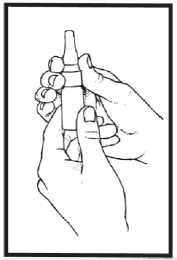
Shake off the excess water and allow the nozzle and dust cap to dry in a warm (not hot) place.
5. Re-fit the nozzle.
6. 'Prime' the bottle as necessary by pumping the spray a few times until a fine mist is produced.
• You should clean your nasal spray at least once a week to stop it from getting blocked up. Additional cleaning is required when your spray becomes blocked.
• You must NEVER attempt to unblock or enlarge the spray hole with a pin or other sharp object because this will destroy the spray mechanism.
When your Fluticasone propionate Nasal Spray is new the bottle must be primed as follows:-
1. Shake the bottle gently
and then remove the dust cap
2. Hold the bottle upright with your thumb under the bottle and your index finger and middle finger on either side of the nozzle.
Ensure that the nozzle is pointing away from you when you do this.
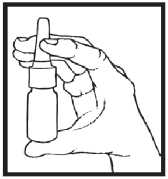
Close one nostril by pressing your finger against it and place the nozzle of the spray in your other nostril. Tilt your head forward slightly so that the bottle is kept upright.
3. Press down with fingers in order to pump the spray.
4. Repeat steps 2 and 3 until a further five times -the bottle is now primed.
4. Breathe in slowly through your open nostril and, at the same time, press the collar of the nozzle down firmly with your fingers to squirt a spray of fine mist into your nostril.

5.
6.
7.
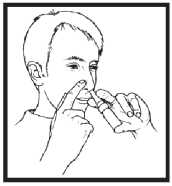
Breathe out through your mouth. Repeat step 4 to take a second spray into the same nostril.
Remove the nozzle from this nostril and breathe out through your mouth.
Repeat steps 3 to 6 with your other nostril.
After using your nasal spray
• Wipe the nozzle carefully with a clean tissue and put the dust cap back on.
If you use more Fluticasone propionate Nasal Spray than you should
It is important that you take your dose as stated on the pharmacist's label or as advised by your doctor. You should use only as much as your doctor recommends; using more or less may make your symptoms worse.
If you accidentally use more Fluticasone propionate Nasal Spray than you were told to use please inform your doctor.
Take this leaflet, and your Fluticasone propionate Nasal Spray, to show the doctor.
If you forget to use Fluticasone propionate Nasal Spray
Do not take a double dose to make up for a forgotten dose. If you forget to take a dose at the right time, take it as soon as you remember. If it is almost time to take the next dose, wait until then and then carry on as before.
If you stop using Fluticasone propionate Nasal Spray
Your nose symptoms may only start to improve after you have been using your medicine for a few days -therefore it is very important that you use your medicine regularly as prescribed, and that you keep using your medicine unless your doctor tells you to stop, even if you feel better.
If you have any further questions on the use of this medicine, ask your doctor or pharmacist.
4. POSSIBLE SIDE EFFECTS
Like all medicines, this medicine can cause side effects, although not everybody gets them.
If you are using high doses of Fluticasone propionate Nasal Spray you may require extra steroids in times of extreme stress, or during admission to hospital after a serious accident or injury, or before a surgical operation. Treatment with nasal corticosteroids may affect the production of steroids in the body. The likelihood of such an incidence is increased by use of a high dose over a long period of time. Your doctor will help prevent this happening by prescribing the lowest dose of steroid capable of adequately controlling your symptoms.
Some side effects are more serious than others and if you should experience any of the following events you should discontinue taking Fluticasone propionate Nasal Spray and consult with your doctor as soon as possible:-
Side effects occurring very commonly (probably affecting more than 1 in 10 patients taking the Fluticasone propionate Nasal Spray)
• epistaxis (nose bleeds).
Side effects occurring commonly (probably affecting up to 1 in 10 patients taking the Fluticasone propionate Nasal Spray)
• headache
• unpleasant taste in the mouth or an unpleasant smell in the nose
• dryness and irritation of the throat and nasal passages and sneezing.
Side effects occurring rarely (probably affecting fewer than 1 in every 1,000 patients taking Fluticasone propionate Nasal Spray)
• severe allergic reaction giving rise to the sudden onset of a rash, swelling (usually of the tongue, face or lips) or difficulty in breathing
• bronchospasm (the narrowing of the airways in the lungs).
Side effects occurring very rarely (probably affecting fewer than 1 in every 10,000 patients taking the Fluticasone propionate Nasal Spray)
• glaucoma (raised pressure in the eye) and cataracts (clouding of the lens in the eye) have been reported following prolonged treatment
• perforation of the nasal septum (the dividing partition in the nose) and ulceration to the nose's mucus membranes - although these usually impact on patients who have had previous surgery to the nose.
Additional side effects in children and adolescents
Children may grow more slowly than others, and therefore children receiving treatment with nasal corticosteroids over a long period of time will have their height checked regularly by their doctor. Your doctor will help prevent this happening by prescribing the lowest dose of steroid capable of adequately controlling the symptoms.
Reporting of side effects
If you get any side effects, talk to your doctor, pharmacist or nurse. This includes any possible side effects not listed in this leaflet. You can also report side effects directly via the Yellow Card Scheme at: www.mhra.gov.uk/yellowcard.
By reporting side effects you can help provide more information on the safety of this medicine.
5. HOW TO STORE FLUTICASONE PROPIONATE NASAL SPRAY
• Keep out of the sight and reach of children.
• Do not store above 25°C.
• Do not use Nasofan Aqueous after the expiry date that is stated on the outer packaging. The expiry date refers to the last day of that month.
• Medicines should not be disposed of via wastewater or household waste. Ask your pharmacist how to dispose of medicines no longer required. These measures will help to protect the environment.
6 . FURTHER INFORMATION
What Nasofan Aqueous Nasal Spray
contains:
• Each metered spray gives 50 micrograms fluticasone propionate per spray in an aqueous suspension.
• Also contains: glucose anhydrous, microcrystalline cellulose, carmellose sodium, phenylethyl alcohol, benzalkonium chloride, polysorbate 80, purified water.
What Nasofan Aqueous Nasal Spray looks
like and contents of the pack:
• White opaque suspension in an amber glass bottle fitted with an atomising metered pump to create the spray.
• Each bottle contains sufficient suspension to deliver 150 metered sprays.
Manufacturer by:
Teva Czech Industries s.r.o,
Ostravska 29,
747 70 Opava- Komarov,
Czech Republic.
Procured from within the EU & repackaged by Product Licence holder:
Kosei Pharma UK Ltd.,
956 Buckingham Avenue,
Slough Trading Estate,
SL1 4NL, UK
Fluticasone propionate 50 micrograms Aqueous Nasal Spray, Suspension
PL 39352/0299
Leaflet date: 29.02.2016

Fluticasone propionate 50 micrograms Aqueous Nasal
Spray, Suspension
(fluticasone propionate)
Package Leaflet: Information for the user